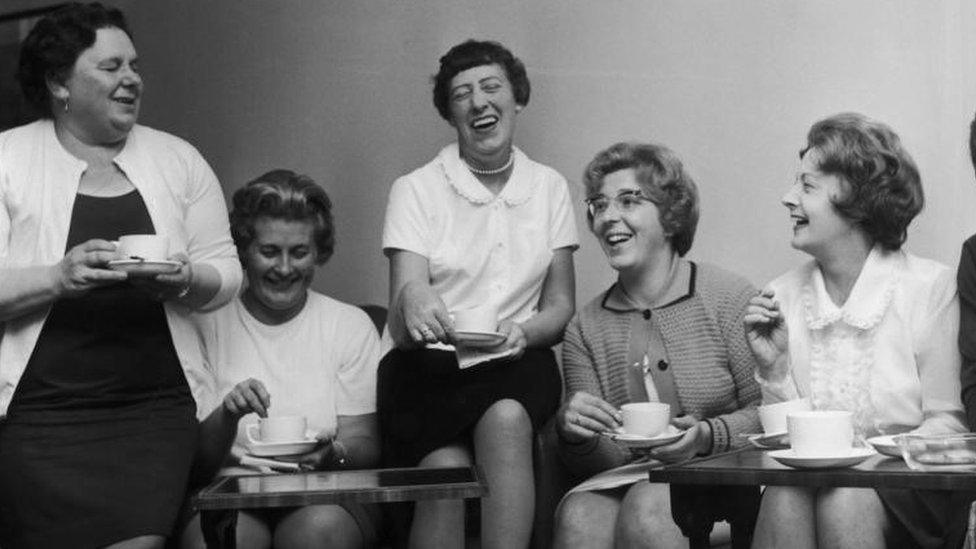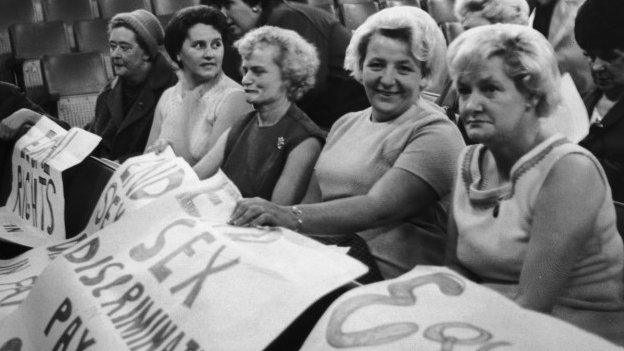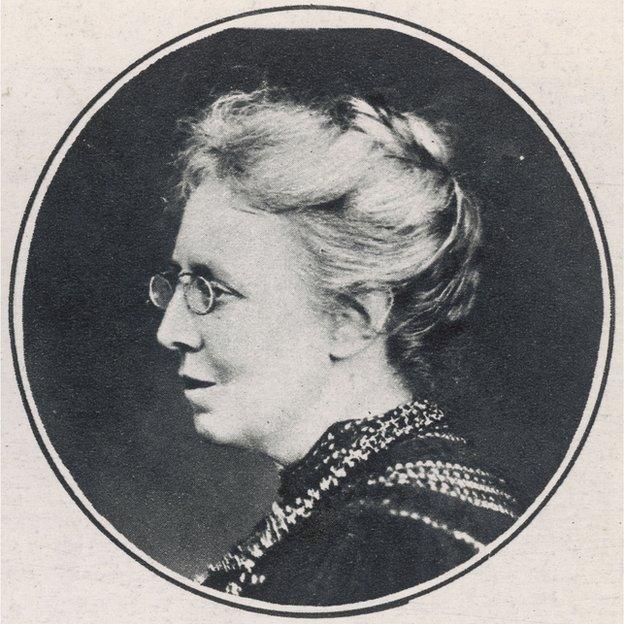Important moments in the fight for equal pay
- Published

On 28 June 1968 a group of the striking Ford machinists met Barbara Castle, the employment secretary, to discuss their grievances
The pay gap between men and women in the UK currently stands at 13.9%, according to the Fawcett Society, which campaigns for women's rights.
Or to put it another way, the society calculates that on average for every £1 a man earns, a woman earns a touch more than 86p.
Here are some of the important moments in the fight to close that gap.

1968: Ford sewing machinists' strike
Immortalised in the 2010 film "Made in Dagenham", this strike by a group of women who stitched the seats for thousands of Ford cars, has become a celebrated moment in the campaign for equal pay.
Originally, however, the strike was more about grading than money. The women wanted to be recognised as semi-skilled workers, which was grade C in the company pay structure, rather than being labelled unskilled workers, which was grade B.

On the same trip to London the women attended a conference on equal rights in industry
Within weeks of the women going on strike in June 1968, Ford was forced to shut down parts of its Dagenham plant.
On 28 June the women took their fight to Whitehall, marching behind a banner which famously read "We want sex". If it had unfurled properly the last word, "equality", would also have been visible, but passing drivers didn't seem to mind.
A group of the strikers met the employment secretary Barbara Castle that day and a deal was brokered.
The women returned to work on 92% of the male pay rate, rather than the 85% they'd been on before the strike and on the promise that their grading would be re-examined.
The machinists had to go on strike again at Christmas 1984 to secure that re-grading.

1970: Equal Pay Act
The Ford machinists' strike is widely seen as one of the spurs to the introduction of the Equal Pay Act in 1970. This stated that men and women were entitled to equal pay.
It allowed claims for similar jobs, or jobs that were different but which the employer had rated as needing similar skill or effort and had put in the same grade.

"Pay" meant contractual pay, so the Act covered benefits including bonuses.
Claims under the Act can only be brought on the grounds of sex discrimination.
In 1975 the EU directive on equal pay established the principle of equal pay for work of equal value, and this was enshrined in law in the UK in 1984.

1988: Cammell Laird kitchen
This is seen as one of the first big tests of the UK's amended 1984 Equal Pay Act and its stipulation of equal pay for work of equal value.
The reluctant hero of this campaign was Julie Hayward who worked as a cook in the Cammell Laird shipyard in Birkenhead. She started as an apprentice at the age of 16 and when she and her fellow apprentices completed their training, the three men in the group got a pay rise - but Julie didn't.

Julie Hayward in the kitchen at the Cammell Laird shipyard
She discovered that they were classed as craftsmen, while she was considered a labourer.
The company argued at an industrial tribunal that you couldn't compare what a woman does in the kitchen with what men do outside in the shipyard. Her male colleagues were a shipboard painter, a joiner and a thermal insulation engineer.
To counter this, Julie's defence produced pictures of her carrying industrial-sized trays of pies for the shipbuilders' lunches and putting them in a piping hot oven.
The tribunal called in an independent expert who analysed the different roles and then ruled that the work was indeed of equal value
Despite the ruling, this was only the start of Julie's legal battle. Finally in 1988, more than four years after she started her equal value claim, the House of Lords found in Julie's favour.

2011: Abdulla Group vs Birmingham council

This fight between Birmingham City Council and a group of its workers established the principle that employees can seek redress in the County Court on equal pay claims for up to six years after leaving their employer.
Claims to an employment tribunal must be submitted within six months.
The original case was brought to tribunal on behalf of some 5,000 workers employed by the city council. They were mainly women in female-dominated roles, such as cooks, carers and cleaners. They had discovered that they weren't being offered the same bonuses as some of their counterparts working as binmen or street cleaners or gravediggers.
One of the women described herself as "absolutely gutted" when she found out.
The council said it had scrapped its "inappropriate bonus schemes" in 2007, nevertheless the workers won their case for equal pay in 2010.
The argument then hinged on whether they were entitled to compensation, given that they were out of time according to the tribunal system. So, 174 of them, who became known as the Abdulla Group, brought a claim for breach of contract in the High Court.
They won the case in 2011, and in 2012 the council, who argued that such cases should be heard by expert employment tribunals, was refused permission to appeal against the decision.

2016: Asda
This is believed to be the biggest legal action in the private sector and could have ramifications for other supermarkets.
It's another case of "equal pay for equal value".

Retired Asda worker Irene Cole has been involved in the campaign
In October a tribunal made a preliminary ruling to the effect that 8,600 (mostly female) workers, mainly working on the check-outs or stacking shelves, can compare themselves to men working in the warehouses - who are earning more money.
The final decision on whether the demands of the jobs are actually comparable is yet to be reached and will be fiercely contested. Asda claims it has never discriminated and has also said: "We continue to strongly dispute the claims".
The stakes are high. If the supermarket loses, workers could recover more than £100m in back pay, going back to 2002, not to mention pay rises in the future.

And finally...
Don't forget the legacy the workers owe to Clementina Black.

She was the pioneering trade unionist who put forward a motion at the trades union congress in 1888 demanding equal pay.
- Published29 August 2016

- Published23 August 2016
